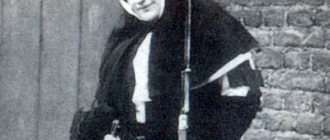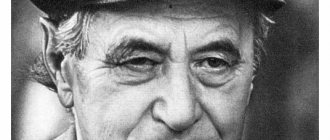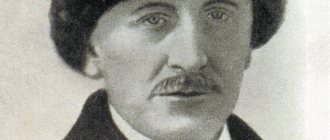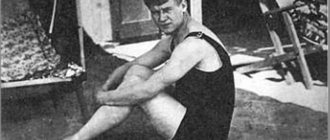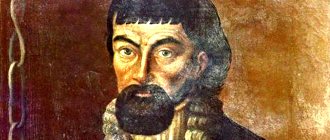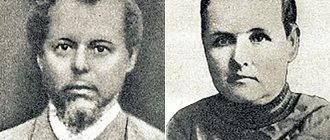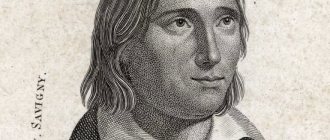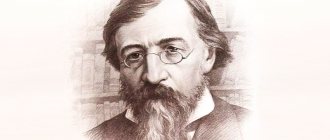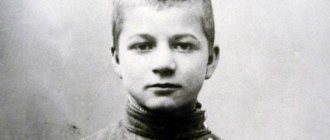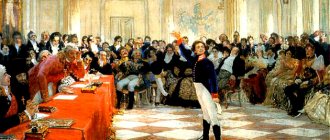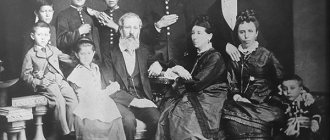Ernst Hoffmann was a German romantic writer, artist, lawyer and composer. He was a very versatile person. During his biography, he managed to create many brilliant works in the field of literature and music.
There are many dramatic moments in Hoffmann's biography, which we will tell you about. But first things first.
So, here is a short biography of Hoffmann .
Biography of Hoffmann
Ernst Theodor Amadeus Hoffmann was born on January 24, 1776 in Königsberg (East Prussia). He grew up in the family of lawyer Christoph Ludwig.
Childhood and youth
When Ernst was 3 years old, his parents decided to divorce. In connection with this, his maternal grandmother and uncle, who worked as a lawyer, were involved in his upbringing.
It is worth noting that Hoffmann’s uncle was a very intelligent and creative person who showed interest in science fiction and mysticism. It was he who prompted the boy to connect his life with jurisprudence.
In addition, his uncle helped him develop his abilities in artistic and musical creativity.
“Königsberg in People”: Ernst Theodor Amadeus Hoffmann
Ernst Theodor Wilhelm Hoffmann was born on January 8, 1776 in Königsberg. Father Christoph Ludwig Hoffmann served as the king's lawyer. Biographers note that he was a man of mood and very prone to drunkenness. Mother Louise Albertine Dörfer was an extremely religious and overly hysterical woman. The married life of these different people was accompanied by scandals, which a few years after the birth of their son led to divorce. Ernst Theodor moved with his mother to the Derfer house. The only person from whom the boy received even a little love and care was Aunt Johanna; the rest, including his mother and grandmother, were completely indifferent to him.
Hoffman received his basic education at a Lutheran school. Already at the age of 12 he was fluent in playing the piano, organ and violin. Obviously, even then he was thinking about what he would prefer: to become a lawyer, as is customary in the Derfer family, or to become a musician. In 1792, Hoffmann entered the Faculty of Law at the University of Königsberg, without leaving his music studies. The first time he heard Mozart's opera Don Giovanni, Hoffmann was shocked. He will even take his middle name Amadeus in honor of his idol. Here fate will play a cruel joke on him: like Mozart, he will work hard all his life and suffer no less, being in eternal poverty. As a student, Hoffman met his first love.
The object of his worship will be Dora Hutt, a married woman, mother of five children. He was 17, she was 26. Hoffmann gave her music lessons. Their meetings lasted four years, but no matter how they hid their love, rumors about their relationship began to circulate around Königsberg. When Dora's sixth child was born, hints of paternity became unbearable. Hoffmann was forced to leave Konigsberg.
Idleness and boredom are the gods and patrons of Königsberg, for both the people one sees here and the air they breathe seem to inspire nothing else.
This is exactly how the most caustic critic of this city, Frederick the Second the Great, nicknamed the old Fritz, spoke about Koenigsberg and its inhabitants, having his own reasons. In 1796, Hoffmann went to the town of Glogau in Silesia. There he had solid support in the person of his uncle, who occupied a prominent position in the city. For two years, Goffman has been working as a court reporter.
According to some reports, Hoffman went to visit his great-uncle Fatten in Rossiten, today the village of Rybachy. What he experienced was later reflected in his short story “Majorat”. The action of the novel takes place in an ancient castle on the southern spit. The young hero, a relative and assistant to an old notary, falls in love with a rich baroness. The same Dora served as the prototype. Love will bring more suffering to the heroes of the story than joy, and will end in separation. Many years later, finding himself in Rossiten, the hero of the story learns that the baroness has died and the castle is no longer there. Many years later, Hoffmann arrives in Königsberg and learns about the death of his beloved Dora.
At the moment when Hoffmann was already putting an end to his life, he received an unexpected assignment to Berlin. Hoffmann immediately liked the bustling life of Berlin. During this period, he painted a lot, copied the works of ancient masters, improved in portraiture, passed the exam for the rank of assessor, after which he received an appointment to Poznan. Of course, he doesn’t want to leave Berlin. In Poznań, he meets Michalina Rohrer-Trzcinska. Without hesitation, he got married in July 1802, simultaneously breaking off his engagement with his cousin Minna Derfer. Soft and patient Mikhalina will become his faithful friend.
Misha, as he affectionately called her, will forgive her husband everything: constant lack of money, oddities, mood swings, excessive addiction to alcohol, love for another woman. She will continue to carry this cross - the cross of the wife of a genius, and Hoffmann will remain torn between two worlds, everyday reality and fantasy, everyday life and illusion. A marriage with a clerk’s daughter, a Polish woman, led to a break with the Derfer family. For Hoffmann, this meant the collapse of all his hopes, because at the same time he was losing the financial support of his rich uncle. The situation in which Hoffmann found himself was further complicated by the fact that he distributed caricatures of influential people in the city. The author of the cartoons was quickly identified, and the verdict was pronounced immediately - Hoffmann had to leave Poznan. Instead of Berlin, where he was about to be assigned and so dreamed of returning, he was actually sent into exile in Plock, a provincial town on the banks of the Vistula.
The most painful thing for Hoffman was the lack of a cultural environment. To overcome despair, he keeps a diary. The most common entries are “an ordinary day,” “a rainy day,” and, finally, “I am left to vegetate, I am forgotten.” His work in court is limited to considering complaints from peasants and passing sentences on chicken thieves, but thanks to the influence of Mikhalina, Hoffman holds on. Researchers believe that it was in Plock that he showed the first signs of schizophrenia, which will only intensify further. In October 1803, in his diary, he writes something like this: “Oh, pain! I am increasingly becoming a state adviser. Who would have thought about this three years ago? The muse escapes through the archival dust. The future looks dark and gloomy. Where are my intentions? Where are my wonderful plans for art?
But it was in Plock that Hoffmann decided to become a writer, and here fate smiled on the recluse. His friend, the influential Theodor Hippel, is seeking Hoffmann's transfer to Warsaw - the exile is over! The Warsaw period is one of the calmest in Hoffmann's life. His daughter Cicily was born here. Official duties take up a lot of time, but Hoffman copes with them quickly and devotes himself entirely to music. Here he staged his first musical works. Both the public and critics accept his productions very favorably. But his entire calm life was suddenly disrupted by Napoleon's invasion in 1807, truly fatal for him.
Hoffman loses his job, he is forced to change his apartment, there is not enough money, he is sick. As soon as he gets back on his feet, he sets off on the road, first to Poznan, then to Berlin. His constant companion is need. Hoffmann himself assesses his situation as desperate. This is followed by the death of his daughter and the serious illness of his wife. He is starving and has bouts of nervous fever. Sometimes, in order to eat, he sells his things. The situation becomes hopeless, and in order to survive, Hoffmann goes to the town of Bamberg, where he is offered the position of theater conductor.
In Bamberg he gets a break. It is here that Hoffmann makes new influential friends. One of them was Karl Kunz, a famous wine merchant, who became his first publisher. It was he who published his first works. This is where he meets Julia Mark. For the first time in many years after Dora, Ernst Theodore Amadeus experiences a real deep feeling. He is well aware that he is 20 years older than her, unattractive, that he has a family and a very modest salary, but he cannot help himself, he is in love. Yulia's mother, realizing how this relationship could end for her daughter, hastily decides to marry Yulia off. Soon the groom appears, a merchant from Hamburg. Hoffman writes in his diary: “The blow was struck. The beloved became the bride of the damned donkey merchant. It seems to me that my entire musical and poetic life has faded. I need to make the decision of the worthy person that I consider myself to be.”
He tries to drown his failures in wine and thinks about suicide. He can no longer live without alcohol. He becomes a regular visitor to the restaurant "At Rose's" and the residents of Bamberg come to see him as a great original. Sometimes Hoffmann has attacks of inexplicable rage, he gets up from the table and turns to a visitor he doesn’t like: “Dearest, you are in the left corner, you can’t even imagine how much I honor you, even though you are an ass.”
After breaking up with Julia, life in Bamberg becomes unbearable, and in April 1813 he literally flees the city. With Mikhalina, Hoffman goes to Leipzig, here he will have a lot of work in the theater. The last act of another tragedy, Napoleonic, unfolds here. It seems that Hoffmann's life is in some kind of fatal dependence on the French emperor.
Napoleon's troops forced him to flee Warsaw, doomed him to starvation in Berlin and, already in a state of agony, overtook him on the way to Leipzig. Only in late autumn do reports of Dresden's capitulation arrive. The French are defeated, and Hoffmann writes to his publisher: “My most beautiful hopes have come true, and my confidence, which remained in the most difficult times, has been confirmed.” At this time, Hoffmann was working on the fairy tale “The Golden Pot”. The author himself will consider this tale, like “The Everyday Views of Murr the Cat,” to be the best among his works.
Soon Theodor von Hippel seeks a place for Hoffmann in Berlin. There he becomes the soul of the Serapion Brothers literary society. Once a week, friends gather in a coffee shop on Unter der Linden, and Hoffmann reads “The Nutcracker and the Mouse King,” “The Bride’s Choice,” and “Captain Gluck.” Hoffmann is at the center of literary life. For the first time in many years of wandering, he had hope of finding a permanent refuge, but Hoffman cannot live only on literature. Therefore, he is forced to return to legal practice and work in criminal court. At the Berlin theater he staged Ondine, the first German romantic opera. The audience greets him with thunderous applause. Hoffmann stands on stage, infinitely happy and moved, he is recognized as a composer and thinks about immortality. He still assigns a secondary role to literature, and when starting to write the novel “The Elixir of Satan,” he expects, first of all, that this thing will provide him with material wealth, but nothing more. Very few years will pass and Hoffmann will be forgotten as a conductor, as an artist, as a graphic artist. Critics will speak very little of his works, operas will practically not arouse any interest, but everywhere and always he will be appreciated as a writer.
For many years, Hoffmann has been concerned with man's desire to create his own mechanical likeness, to create a robot, an automaton. It is to the talking doll, skillfully parading people, that his famous short story “The Sandman” is dedicated. Hoffmann clearly expressed his attitude towards humanoid machines in his short story “Automata”/
I am deeply disgusted by these mechanical figures, these monuments either to living death or to dead life.” Hoffmann is particularly outraged by the fact that machines are invading the spiritual, creative sphere, the sphere of music: “To combine a living person with dead figures that only copy the form and movements of a person - for me this contains something grave, ominous and even completely creepy.” . The desire of mechanics to increasingly more accurately copy and replace the organs of the human body with mechanical devices is, in my eyes, an open war against the principles of spirituality.
In “The Sandman” in the image of Olympia, a mechanical doll with whom the hero of the novel falls in love, we are not talking about successfully copying the human body, but about replacing it. If in the short story “Automata” Hoffmann still believes in the victory of the spirit, then in “The Sandman” this faith collapses.
During this period, his works were well published, his income grew, but it was barely enough to visit the Wagner wine cellar. He needs wine to write. It, according to him, gives lightness and bright dreams, but more often causes nightmarish visions and monstrous ghosts. He writes without any ambitious passion, but, it seems, out of the sole desire to live a different imaginary life, taking revenge on everyday life. As he wrote, you can read from Herzen: “Every single day, late in the evening some man appeared in a wine cellar in Berlin. I drank one bottle after another and sat until dawn. It was then that strange, ugly, gloomy, terrible shadows filled Hoffmann, and in a state of extreme irritation he grabbed a pen and wrote his convulsive, crazy stories.”
Work in court, a huge amount of writing, and everyday nightly sprees are not in vain. Hoffmann, who had always had poor health, became seriously ill in the spring of 1818. For several weeks he balances on the brink of life and death, but even in this state he writes the fairy tale “The Cat Tsakhes, nicknamed Zinnober.” In the fairy tale, the poet Balthazar, in love with Candida, exposes Tsakhes. Hoffmann believes in the great power of art, but in the real world things are much worse. Hoffmann is rapidly approaching a tragic ending. In the summer, together with Michalina, he travels to Silesia to improve his health, while at the same time in Berlin, his short story “Mademoiselle de Scudery” brings Hoffmann his greatest success as a writer.
It seems that he finally has a bright future ahead of him, but the authorities accuse Hoffmann of disclosing state secrets in the novel “The Lord of the Fleas.” Events take place in Frankfurt. The authorities are not embarrassed that Hoffman is in serious condition and can no longer cope without outside help. The manuscript was withdrawn from the press; it will subsequently be published, but with severe abbreviations. My wife and friends are on duty at my bedside day and night. As soon as Hoffmann felt relieved, he began to dictate his stories; he really wanted to create a novel about his devoted Mikhalina, but the plan never came to fruition. On June 24, paralysis reached the writer’s neck, and he stopped feeling pain. “He’ll probably feel better soon,” he shouted hopefully to the arriving doctor. “Nothing hurts at all anymore.” “Yes,” the doctor answered understandingly. “You’ll feel better soon.”
The next morning, June 25, 1822, Hoffmann died. Three days later, Theodore Amadeus was buried quietly and unnoticed in the new cemetery in front of the Gali Gate in Berlin. With funds raised by his friends, a modest monument was erected. A few days later, creditors sold all of Hoffmann’s belongings at auction: furniture, gold watches, violins, an advisor’s embroidered uniform, books. Unfortunately, he left his wife nothing but debts. Only one creditor, the owner of a wine cellar, forgave him all his debts.
Schizophrenia, delirium tremens, delirium of a madman - whatever you want to call it, but this is exactly how the contemporaries perceived the strange gentleman from Königsberg. They can be forgiven; the author of “The Everyday Insights of Murr the Cat” is an ordinary genius. About himself, Hoffmann literally wrote the following: “I am like children who were born on Sunday, because they see what other people do not see.”
Interestingly, in Russia Hoffman was recognized immediately and unconditionally. Its popularity began to really increase by the 30s of the 19th century. His first book was published in 1822. It was the short story “Maiden Scuderi”. Year of Hoffmann's death. And after 10 years, 62 stories of the great German writer were published in Russian. By that time, there was, perhaps, not a single writer who had not read Hoffmann and was not fascinated by his work. Zhukovsky and Pushkin, Odoevsky and Gogol, Dostoevsky and Aksakov, Lermontov and Tolstoy. Hoffmann became so popular that already in the 30s the name and biography of the writer, like all great people, began to become overgrown with rumors and absurdities, that, they say, he did not die, he moved to Russia, that not so long ago they saw him at a ball at the general -governor. He waltzed with his daughter and laughed so well. He was trying to conduct an orchestra, and gold chervonets were falling out of his pocket...
Illustrations from the site www.vitanova.ru.
Music
During the period of biography 1807-1808. Hoffmann lived in Berlin. At this time, he made money as a tutor, teaching music lessons.
However, this money was completely insufficient even for a meager existence, as a result of which he often experienced serious financial difficulties.
Nevertheless, Hoffmann continued to be interested in art, because only in it did he see the meaning of life. Over time, he discovered his talent as a composer.
Over the course of several years, he wrote many musical works, including the operas Aurora and Ondine, the ballet Harlequin and piano sonatas.
In 1808, Hoffmann worked as a theater conductor. After that he conducted in German theaters.
An interesting fact is that when he was about 30 years old, he changed his name from “Wilhelm” to “Amadeus”, since he was a great admirer of Mozart. It is fair to say that he also proved himself excellent as a music critic.
Hoffmann's biographers agree that his literary works are inseparable from music. This can be clearly seen in the short stories “Cavalier Gluck” and “Kreisleriana”.
In 1815, Hoffmann lost his position as bandmaster, and therefore was forced to return to the service he hated so much. However, working as a lawyer allowed him to be financially independent and left him plenty of time for creativity.
The main features of the work of E.T.A Hoffmann
The period of Hoffmann's literary creativity falls on the heyday of German romanticism. In the writer’s works one can trace the main features of the Jena school of romanticism: the implementation of the idea of romantic irony, recognition of the integrity and versatility of art, the embodiment of the image of an ideal artist. E. Hoffmann also shows the conflict between the romantic utopia and the real world, however, unlike the Jena romantics, his hero is gradually absorbed by the material world. The writer makes fun of his romantic characters who strive to find freedom in art.
Works of Hoffmann
In 1809, Ernst Hoffmann published the short story “Cavalier Gluck,” which became the first work in his creative biography. After that, he wrote many more short stories, which were later combined into the collection “Fantasies in the Manner of Callot.”
During his life, Hoffmann composed dozens of fairy tales, stories and novels. Many animated and feature films have been made based on his works. In addition, performances based on the playwright's plays are staged all over the world.
As a writer, Hoffman realized himself most of all in the last decade of his biography. The following works brought him the greatest popularity:
- "Elixirs of Satan";
- "Lord of the Fleas";
- “The Life Beliefs of Murr the Cat”;
- "The Nutcracker and the Mouse King";
- "Serapion's brothers."
Literary creativity
In 1816, Hoffmann is offered a position in Berlin, and he resigns himself to the need to serve for the sake of money. But there is no longer a need, and he devotes all his free time to literary work. It was then that masterpieces were created that brought the author world fame. Hoffmann finished the novel “Elixirs of Satan” in 1815, and the collection “Serapion’s Brothers” in 1820. At the same time, he works on small works: stories, fairy tales, novellas. The author has been writing the two-volume book “The Everyday Views of Murr the Cat” for about 3 years. After finishing work at the end of one thousand eight hundred and twenty-one, his beloved cat dies. This has a depressing effect on Hoffmann. In 1822, the writer was already very ill, but finished writing the novel “Lord of the Fleas,” which irritated members of the government with its sharp satire. The entire work would not be published until 1906.
Personal life
During his biography, Hoffman repeatedly fell in love with women. While still a student, he dated a young girl, Dora, for several years. However, he could not propose to her because she was married and had five children.
In 1800, Hoffmann met Michaelina Rohrer-Trzczyńska. The young people often communicated and found a lot in common with each other. After 2 years, he realized that he was in love with a girl.
For this reason, Hoffmann broke off his engagement to his cousin Minna Dörfer in order to marry Michaelina. An interesting fact is that for the sake of his future wife, he converted to Catholicism.
Hoffmann never regretted his decision. He loved his wife to the point of unconsciousness, who supported him in every possible way and was a reliable support for him.
